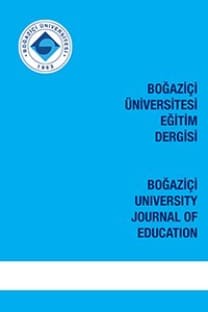Dil Eğitiminde Derlem Temelli Yaklaşımlar: Çıktılar, Gözlemler ve Öğretmen Görüşleri
Öz
This paper is a synthesis of teacher perspectives, analyses of learner output and learner impressions, ideas for materials development, and summative researcher observations resulting from the implementation of a semester-long (around 8 weeks of instruction) corpus-based and data-driven English as a Second Language (ESL) instruction in two university-level and adult study abroad settings in the United States (U.S.). Case Study 1 investigates learner and instructor attitudes regarding the effectiveness of corpus-based instruction in developing academic writing skills specifically designed for a group of visiting Chinese scholars. Case Study 2 follows a mixed-methods, exploratory investigation into the use of a scaffolded student worksheet to guide learners with different proficiency levels in the use of corpora and corpus tools during a semester-long study abroad program at a non-profit, private institution based in the U.S. The worksheet was designed to regularly incorporate corpus-based lessons and data into the classroom instruction or into homework activities. Results reveal instructor enthusiasm for the potentially vast and promising benefits of incorporating corpus tools into their own language classroom instruction. With specific and clear learning goals and instruction on their use, corpus tools can be a valuable resource for appropriate students during and after completion of the course.
Anahtar Kelimeler:
Derlem dilbilim, öğretmen algıları, veri güdümlü öğrenme, sınıfiçi teknoloji
Corpus-Based Approaches in Language Teaching: Outcomes, Observations, and Teacher Perspectives
Keywords:
Corpus linguistics, teacher perception, data-driven learning, technology in the classroom,
___
- Anthony, L. (2018). AntConc (Version 3.4.3) [Computer Software]. Tokyo, Japan: Waseda University. Accessed July 9. http://www.laurenceanthony.net/
- Biber, D., Reppen, R., & Friginal, E. (2010). Research in corpus linguistics. In R. B. Kaplan (Ed.), The Oxford handbook of applied linguistics (2nd Ed.) pp. 548- 570. Oxford: Oxford University Press.
- Boulton, A. (2009). Testing the limits of data-driven learning: Language proficiency and training. ReCALL, 21(1), 37-54.
- Bowker, L., & Pearson, J. (2002). Working with specialized language: A practical guide to using corpora. New York: Routledge.
- Cortes, V. (2011). Genre analysis in the academic writing class: With or without corpora?. Quaderns de Filologia-Estudis Lingüístics, 16, 65-80.
- Davies, M. (2008). The Corpus of Contemporary American English (COCA): 520 million words, 1990-present. Available online at https://corpus.byu.edu/coca/.
- Engle, L., & Engle, J. (2003). Study abroad levels: Toward a classification of program types. Frontiers: The Interdisciplinary Journal of Study Abroad, 9(1), 1-20.
- Firth, J. (1957). Papers in linguistics. Oxford, UK: Oxford University Press.
- Flowerdew, L. (2005). An integration of corpus-based and genre-based approaches to text analysis in EAP/ESP: Countering criticisms against corpus-based methodologies. English for Specific Purposes, 24(3), 321-332.
- Flowerdew, L. (2015). Data-driven learning and language learning theories: Whither the twain shall meet. In Leńko-Szymańska, A. & Boulton, A. (Eds.), Multiple affordances of language corpora for data-driven learning (pp. 15-36). Philadelphia, PA: John Benjamins North America.
- Friginal, E. (2013). Developing research report writing skills using corpora. English for Specific Purposes, 32(4), 208-220.
- Friginal, E. (2018). Corpus linguistics for English teachers: New tools, online resources, and classroom activities. New York: Routledge.
- Friginal, E., & Hardy, J.A. (2014). Corpus-based sociolinguistics: A guide for students. New York: Routledge.
- Geluso, J., & Yamaguchi, A. (2014). Discovering formulaic language through datadriven learning: Learner attitudes and efficacy. ReCALL, 26(2), 225-242.
- Gilquin, G., Granger, S., & Paquot, M. (2007). Learner corpora: The missing link in EAP pedagogy. Journal of English for Academic Purposes, 6(4), 319-335.
- Kaltenböck, G., & Mehlmauer-Larcher, B. (2005). Computer corpora and the language classroom: On the potential and limitations of computer corpora in language teaching. ReCALL, 17(1), 65-84.
- Lee, D., & Swales, J. (2006). A corpus-based EAP course for NNS doctoral students: Moving from available specialized corpora to self-compiled corpora. English for Specific Purposes, 25(1), 56–75.
- Meunier, F., & Reppen, R. (2015). Corpus vs. non-corpus informed pedagogical materials: Grammar as the focus. In D. Biber & R. Reppen (Eds.) The Cambridge handbook of English corpus linguistics (pp. 498 – 514). Cambridge: Cambridge University Press.
- Römer, U. (2009). The inseparability of lexis and grammar: Corpus linguistic perspectives. Annual Review of Cognitive Linguistics, 7, 140-162.
- Römer, U. (2011). Corpus research applications in second language teaching. Annual Review of Applied Linguistics, 31, 205 – 225.
- Smart, J. (2014). The role of guided induction in paper-based data-driven learning. ReCALL, 26(02), 184–201.
- Teubert, W. (2005). My version of corpus linguistics. International Journal of Corpus Linguistics, 10(1), 1-13.
- Tribble, C. (2015). Teaching and language corpora: Perspectives from a personal journey. In Leńko-Szymańska, A. & Boulton, A. (Eds.), Multiple affordances of language corpora for data-driven learning (pp. 45-67). Philadelphia, PA: John Benjamins North America.
- Yoon, H., & Hirvela, A. (2004). ESL student attitudes toward corpus use in L2 writing. Journal of Second Language Writing, 13, 257–283.
- ISSN: 1300-9567
- Yayın Aralığı: Yılda 2 Sayı
- Başlangıç: 1976
- Yayıncı: Boğaziçi Üniversitesi
Sayıdaki Diğer Makaleler
Ödev Koşullarının İkinci Dil Performansına Etkileri: Karmaşıklık Ölçütlerinin İncelenmesi
Üçüncü Dil Deneyiminin Bilişsel Etkileri ve Dil Yetisinin Rolü
Soruyu bir de Şöyle Soralım: Dil Öğretmenlerinin Söylemleri ile Sınıf içi Eylemleri Tutarlı mıdır?
Dil Eğitiminde Derlem Temelli Yaklaşımlar: Çıktılar, Gözlemler ve Öğretmen Görüşleri
